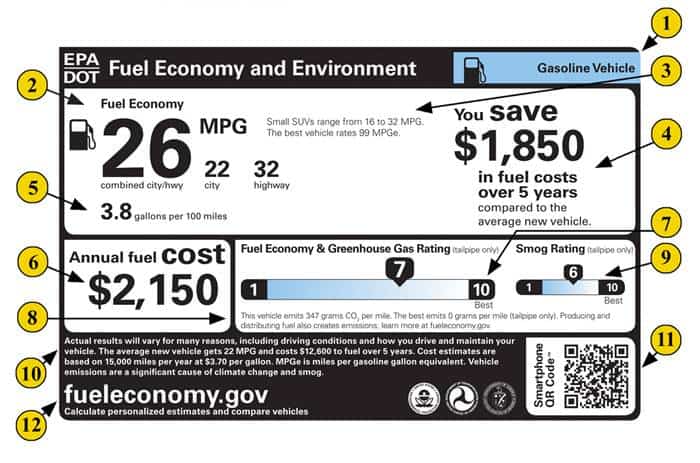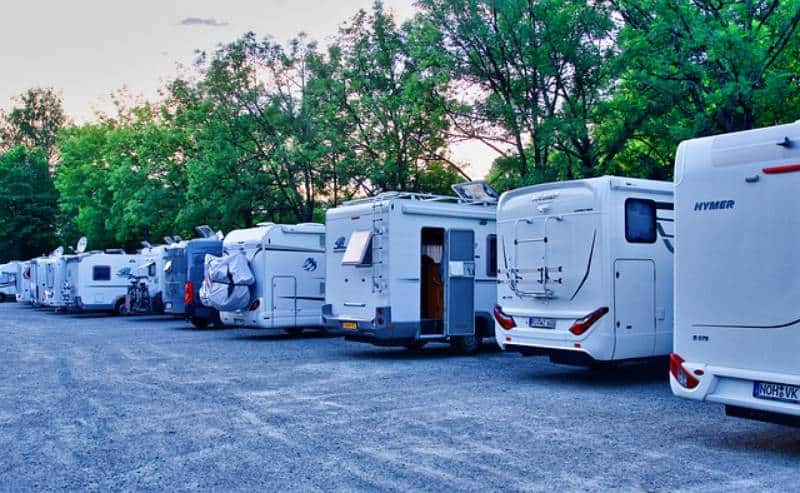Wondering what’s the gas mileage of a motorhome?
Bad news, folks. RVs are exempt from EPA fuel economy ratings.
Every passenger car and light truck sold in America has a fuel economy rating. When you stroll past new cars at the dealership, you’ll see a sticker like this:

The sticker tells you the combined average fuel efficiency (26 mpg), the highway rating (32 mpg), the city fuel economy (22 mpg), and even shares some comparative context.
No such sticker is glued to the window of any Fleetwood, Thor, Winnebago, or Holiday Rambler. There are no standardized fuel efficiency ratings for RV motorhomes. May as well ask your RV salesman who he thinks will win the Super Bowl.
So when I navigate the web page for the 2021 Tiffin Allegro Breeze, I see peak horsepower, peak torque, GAWR and GVWR and GCWR, and even fuel tank size – but there’s not a word about gas mileage.
The manufacturers have abandoned us.
Hence why the question, “What’s your fuel efficiency for X brand Y model Z year?” is such a common post in online forums. (More on that in a minute).
If you’re running late to work and don’t have time for the rest of this article, here’s a table of common gas mileage ranges by RV type.
| Gasoline (mpg) | Diesel (mpg) | |
|---|---|---|
| Class A Coach | 4-9 | 6-14 |
| Class C Coach | 6-14 | 14-18 |
| Class B Van | 15-22 | 17-25 |
Which Motorhomes are the Most Fuel Efficient?

If you googled, “What RVs have the best gas mileage,” then you’re probably looking for a list like this:*
(P.S. Keep reading but don’t trust these numbers! They are fake!!)
Most Fuel-Efficient Class A Coaches
- Thor Palazzo: 10.1 mpg
- Fleetwood Bounder: 7.3 mpg
- Holiday Rambler Admiral: 9.2 mpg
- Winnebago Intent: 6.5 mpg
Most Fuel-Efficient Class B Vans
- Winnebago Travato 59G: 18.5 mpg
- Pleasure-Way Ontour: 17.5 mpg
- Roadtrek Play: 19.8 mpg
- Regency Ultra Continental: 20.1 mpg
Most Fuel-Efficient Class C Motorhomes
- Winnebago Minnie Winnie: 15.1 mpg
- Forest River Sunseeker: 14.2 mpg
- Jayco Redhawk: 12.3 mpg
- East to West Entrada: 11.7 mpg
*Guess what? I made all these numbers up. They’re absolute rubbish.
Besides the fact that I invented them out of thin air, they’re rubbish for two other reasons.
- Without knowing the floor plan as well as the make and model, gas mileage estimates are suspect at best. The 2021 Forest River Forester LE Class C motorhome is available in nine floor plans from 24 to 32 feet. You really think the 24-ft version gets the same gas mileage as the 32-ft version?
- Gas mileage is a range, not a number. No RV gets 7.4 mpg. It gets 6/9/4 mpg (city/highway/mountain), with 7.4 as the average over X,000’s miles. Without knowing the high/low context, you’re taking a shot in the dark.
There are other online lists for “most fuel-efficient RVs,” and from what I can see, most are compiled using similar guesswork and copy-pasting responses from online forums. I know of no single source for accurately reporting RV fuel economy standards.
So rather than take a similar flip of the coin, I have some other (better) advice for you:
How to (Really) Figure Out Your Motorhome Gas Mileage
Wondering what it costs in gas to drive a motorhome? Here are five options!
- Do a back-of-the-envelope calculation using class averages.
- Join an owner’s group and ask for mpg reports from other owners.
- Compare your prospective RV to a rental RV.
- Run your own math.
- Try the coasting test.
Let’s look at each one in more depth.
1. Estimate from the average class fuel economy.
Here’s a table of average RV gas mileage by type:
| Gasoline (mpg) | Diesel (mpg) | |
|---|---|---|
| Class A Coach | 4-9 | 6-14 |
| Class C Coach | 6-14 | 14-18 |
| Class B Van | 15-22 | 17-25 |
As you can see, there’s a wide range for each class!
Jump to the “Factors that Decrease RV Gas Mileage” section to estimate whether your intended RV scores toward the lower or higher end of the spectrum.
If you’re just looking for a quick n’ dirty guestimate, consider these observations:
- Undersized engines, wide-body designs, heavy slide-outs, sharp outside corners, and Big n’ Tall profiles lead to poor fuel efficiency.
- Diesel engines, compact profiles, rounded corners, and enclosed underbellies improve fuel efficiency
2. Join an Owner’s group and ask others for mpg reports!
Every major manufacturer either has an Owner’s Group, online forum, or social media group. Some of these groups are sponsored by the company; others are independently operated by customers.
Forums are rather infamous for dishing out the wrong answers, but in the case of mpg estimates, they do a pretty good job! People will normally tell you the make, model and floor plan of their RV, average calculated mpg, and driving conditions.
3. Call an RV rental company for an estimate.
If you can find a similar rental RV online, reach out to the owner and ask about their experiences. You can view individual listings at peer-to-peer RV rental websites like Outdoorsy, RVShare, RVEzy, or RVnGo. Sometimes, private owners will post mpg ratings!
You can also reach out to major national chains like Cruise America, El Monte, or Escape Vans. For instance, I pulled these estimates from El Monte RV, a nationwide RV rental service:
Class C models
- 18-22 ft models: 8 – 10 mpg
- 23-25 ft models: 7 – 9 mpg
- 27-29 ft models: 6 – 8 mpg
Class A models
- All sizes: 5 – 7 mpg
Meanwhile, Cruise America says, “On average, each RV rental from Cruise America comes in around 6-10 MPG.”
If you’re driving a medium-duty truck or towing with a passenger vehicle, you can find owner MPG reports at sites like Fuelly.com.
4. Do your own math!
If you are already the proud owner of a motorhome, calculating your average fuel efficiency is easy! Just divide miles driven by gallons of fuel consumed. (It’s easiest if you start and end with a half-full tank.)
Example: 470 miles divided by 50 gallons = 9.4 mpg.
5. Try the Coasting Trick
If you’re only trying to figure out relative fuel economy, try this trick:
Find a flat, lonely section of roadway. Accelerate to 70 mph, hold for 10 seconds, shift into neutral, and then coast to 30 mph. Record your time decelerating from 70 to 30 mph.
Next, take your prospective motorhome on a test drive, and perform the same test in the same place (at the same wind and weather conditions). How do the times compare?
5 Methods to Improve Motorhome Fuel Economy

1. Maintain Your Engine!
You know the drill: regularly change the oil and filter, replace the air filter, swap out the spark plugs, install a new air filter, etc. A tuned engine is an efficient engine.
2. Air Up the Tires
As I’ve talked about before, you should carefully check your RV tire pressure to prevent blow-outs!
As a bonus, inflated tires can also improve fuel economy by a few percentage points due to less rolling resistance.
3. Downsize
It’s not popular advice, but if you’re deadset on improving your fuel economy, get a smaller RV! As a rule, smaller RVs get better fuel efficiency. But this rule mostly applies within the same class only.
Example: A smaller Class A with a Cummins L9 diesel will likely have much better gas mileage than a stretched Class C with a Triton V10 gas engine, even though a Class C is “supposed to be” smaller than a Class A!
4. Get a Diesel
“Gas is for cleaning parts, alcohol is for drinking, and diesel is for power.”
Pretty good quote, eh? Here’s another one I like:
“Real trucks don’t have spark plugs.”
Anyway, diesel engines have a well-deserved reputation for durability and efficiency. By their nature, diesel engines are 10-30 percent more efficient than gasoline engines.
You can find a diesel engine in almost any size of motorhome. For instance, you can find the Cummins L9 engine in many diesel Class A’s and the Mercedes-Benz BlueTec 3.0 V6 in Class B vans and smaller Class C cutaway chassis.
5. Drive Smart
- Drive like you don’t have brakes. Coast into highway off-ramps (but don’t shift into neutral! Very dangerous!)
- Accelerate slowly. Don’t push down the gas pedal by more than an inch or two at a time.
- Don’t exceed 55-60 mph. Fuel efficiency plummets at high speeds due to exponential wind resistance.*
- Don’t idle. If you’ll be parked longer than 30-45 seconds, shut ‘er off! Better for the planet and your wallet.
- Use cruise control. You probably can’t drive better than the algorithm!
- Avoid I-95. And I-80. And I-5. And the DC beltway. And other congested highways with stop n’ go traffic and kill your efficiency.
*… Unless, of course, your transmission is tuned to shift into 6th gear at 63 mph, in which case you might get better gas mileage cruising at 64 rather than buzzing into the high range of 5th at 57 mph!
Pro Hint: Most Allison transmissions have an ECON mode which reduces those pesky downshifts on rolling hills terrain!
What’s Not On This List
- Turn off the air conditioning. Yes, turning off the air conditioning saves fuel, but honestly, who listens to this advice? No one. Absolutely no one. Especially when it’s over 80 degrees outside.
- Pack light. A few hundred pounds of weight in most RV isn’t going to impact your fuel efficiency. Don’t sweat the small stuff.
- Install a fuel economy chip. Installing an aftermarket engine performance chip will usually void the manufacturer’s warranty, which can easily cost far more than you’ll save in gas prices.
Leave a Reply